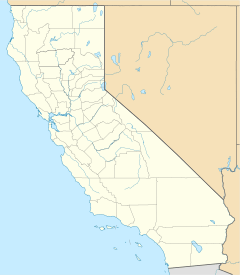Gaston, California facts for kids
Quick facts for kids
Gaston
|
|
|---|---|
| Country | |
| State | |
| County | Nevada County |
| Elevation | 5,062 ft (1,543 m) |
Gaston was once a busy mining town in Nevada County, California. It sits high up at 5062 feet (1543 meters) on a place called Gaston Ridge. This area was known for its wild and beautiful scenery. Gaston is about 3.25 miles (5.2 km) south of Graniteville. It's also about 4 miles northeast of Washington, near Gaston and Hoosier Roads, inside the Tahoe National Forest.
Contents
Gold Mining in Gaston
Gold mining began in Gaston around 1856. At first, miners looked for gold in surface gravels. When that gold ran out, they started "hard rock" mining. This meant digging deep into the earth to find gold hidden in rocks.
The California Mine
The first big mine was called the California mine. It was started by J. J. Meachum and others. This mine was very successful! A mill nearby crushed 15,000 tons of rock. This rock produced gold worth $8 to $9 per ton. Sadly, the mill burned down in 1863.
Lumber Industry
Besides mining, Gaston also had a strong lumber industry. Many sawmills were built to cut down trees. This helped the town grow even more.
Life in a Mining Town
Life in mining towns like Gaston could be tough. There were often conflicts between people. One time, a serious argument happened between two mining partners. It was not about gold, but about a foot-race. One partner, Valentine Brand, was killed by William Myers. Myers was later found guilty of a lesser crime. This shows how wild and unpredictable life could be in these early mining communities.
Growth of the Gaston Mine
Over the years, the California mine continued to make money. It was often expanded. In 1870, a water system called the North Bloomfield ditch brought plenty of water to the mine. By 1897, the mine had produced about $600,000 worth of gold.
New Owners and Upgrades
The mine changed hands several times and became known as the Gaston Mine. In 1898, the Gaston Gold Mining Company bought it. This company had a lot of money. They invested in new equipment and made big improvements.
More Workers, Bigger Town
With these changes, more people came to work at the mine.
- In 1898, there were 20 workers.
- By 1900, there were 50 workers.
- In early 1907, there were 90 workers.
As the mine grew, so did the town around it. In 1900, about 200 people lived in Gaston.
Town Life and Services
Gaston had good services for its size.
- Transportation: There was stagecoach service to the town of Washington. Later, there was daily service to Nevada City.
- Businesses: By 1904, Gaston had two stores, a hotel, a saloon, and a hardware store.
- Community: The town also had a post office, a water system, a fire company, and a school.
- Modern Conveniences: In 1904, electric lights arrived! A telephone line also connected Gaston to Nevada City.
"New Town" and Immigrants
Soon, many Italian immigrants came to Gaston to work in the mine. They created a "New Town" area below the "Old Town." Many Italians cut wood and made charcoal for the mine's equipment.
Gaston's Post Office
The post office in Gaston opened in 1899. Mary Harmon was the first postmaster. She was also the first female postmaster in all of Nevada County! Ellen Whitaker took over in 1904. The post office closed in 1913.
Other Mines and Decline
While the Gaston Mine was the main one, other mines like the Baltic, Ethel, and Erie Mines were also in the area. Between 1899 and 1907, the Gaston Mine produced about $1 million in gold.
Challenges and Closure
The mine temporarily closed in 1907 due to a harsh winter. It also faced money problems after the San Francisco earthquake. It reopened in 1909 and worked on and off for a few years. In 1916, it was the first mine in Nevada County to use a new machine called the Hardinge Mill. This machine made it easier to get gold from the rock.
The mine closed during World War I because workers and supplies were needed for the war. There was some mining after the war, but by the 1940s, the last building in Gaston was falling apart. After World War II, the area was heavily logged for timber. Today, there are no visible signs left of the old town of Gaston.



